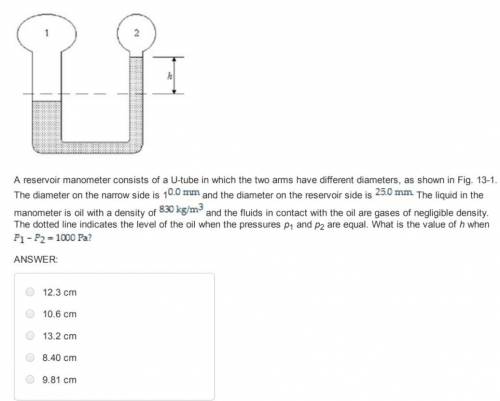
A reservoir manometer consists of a Utube in which the two arms have different diameters, as shown in Fig. 131. The diameter on the narrow side is 10.0 mm and the diameter on the reservoir side is 25.0 mm. The liquid in the manometer is oil with a density of 830 km/m-3 and the fluids in contact with the oil are gases of negligible density. The dotted line indicates the level of the oil when the pressures p1 and p2 are equal. What is the value of h when p1-p2=1000?


Answers: 3
Another question on Physics

Physics, 21.06.2019 16:00
Apiano tuner uses a tuner to create a tone of 5.00 x 10² hz. when a key on the piano is struck he hears 5 beats per second. what is a possible frequency of vibration for the piano string? 2500 hz 1300 hz 605 hz 495 hz
Answers: 1

Physics, 21.06.2019 22:30
Follow these directions and answer the questions. 1. shine a pencil-thin beam of light on a mirror perpendicular to its surface. (if you don't have a laser light as suggested in the video, you can make a narrow beam from a flashlight by making a cone from black construction paper and taping it over the face of the flashlight.) how does the light reflect? how does the relationship of incident to reflected ray relate to the reflection of water waves moving perpendicular to a barrier? 2. shine a pencil-thin beam of light on a mirror standing on a sheet of paper on the table (or floor) so that you can mark the incident ray and reflected ray. (you can support the mirror from the back by taping it to a wooden block.) 3. mark a line on the paper representing the reflective surface. (the reflective surface of a mirror is usually the back edge.) 4. draw a dashed line perpendicular to the mirror surface at a point where the incident and reflected ray meet. this perpendicular is called a normal to the surface. 5. measure the angles between the rays and the normal. the angle of incidence is the angle formed by the incident ray and the normal to the surface. the angle formed by the reflected ray and normal is called the angle of reflection (r). what is the angle of incidence? what is the angle of reflection? 6. repeat for several different angles. (see report sheet for details.) what appears to be the relationship between the angle of incidence and angle of reflection? in science 1204, what was the relationship for these two angles made by the reflection of waves in a ripple tank? 7. roll a ball bearing so that it hits a fixed, hard surface (a metal plate) at several angles (including head-on). observe the way in which the ball bearing reflects. what generalization can you make about how a ball bearing reflects from a wall? have you proved that light can only behave like a wave?
Answers: 1

Physics, 22.06.2019 00:00
Ahypothesis is? close agreement by competent observers of observations of the same phenomena. a guess that has been tested over and over again and always found to be true. an educated guess that has yet to be proven by experiment. the long side of a right triangle. a synthesis of a large collection of information that includes guesses.
Answers: 2

Physics, 22.06.2019 10:40
Two point charges are on the y axis. a 3.90-µc charge is located at y = 1.25 cm, and a -2.4-µc charge is located at y = −1.80 cm. (a) find the total electric potential at the origin. v (b) find the total electric potential at the point whose coordinates are (1.50 cm, 0). v
Answers: 1
You know the right answer?
A reservoir manometer consists of a Utube in which the two arms have different diameters, as shown...
Questions

Mathematics, 17.09.2021 21:40





Mathematics, 17.09.2021 21:40


Mathematics, 17.09.2021 21:40

English, 17.09.2021 21:40

Mathematics, 17.09.2021 21:40

Mathematics, 17.09.2021 21:40


Biology, 17.09.2021 21:40

Computers and Technology, 17.09.2021 21:40

Mathematics, 17.09.2021 21:40

Biology, 17.09.2021 21:40


Physics, 17.09.2021 21:40

Mathematics, 17.09.2021 21:40



